Abstract
This study was initiated to examine the differential expression of an evolutionary conserved human 55-kd actin-bundling (p55) protein that is induced in B lymphocytes by Epstein-Barr virus infection. Our study demonstrates that p55 is specifically expressed at constitutively high levels in human peripheral blood dendritic cells and lymph node (interdigitating) dendritic cells. Blood dendritic cells constitute a minority (< 2%) of all blood leukocytes but are a distinct population of potent antigen-presenting cells. Immunofluorescence microscopy with a monoclonal antibody specific for p55 showed that 87% of peripheral blood dendritic cells stained brightly in the cytoplasm and in the veiled cytoplasmic extensions. In contrast, monocytes, granulocytes, T cells, and B lymphocytes showed no expression of the p55 protein. Western blot analysis confirmed that only the dendritic cell component of peripheral blood expressed high levels of p55. Staining of human lymph node sections demonstrated selective expression of the p55 antigen by dendritic cells in the T-cell-dependent areas but not in the B cell follicles. p55 is likely to be involved in the organization of a specialized microfilament cytoskeleton in the dendritic cells, and the anti-p55 antibody should be useful for further characterization of this important population of antigen-presenting cells in clinical transplantation, HIV-1 pathogenesis, and autoimmune diseases.
Full text
PDF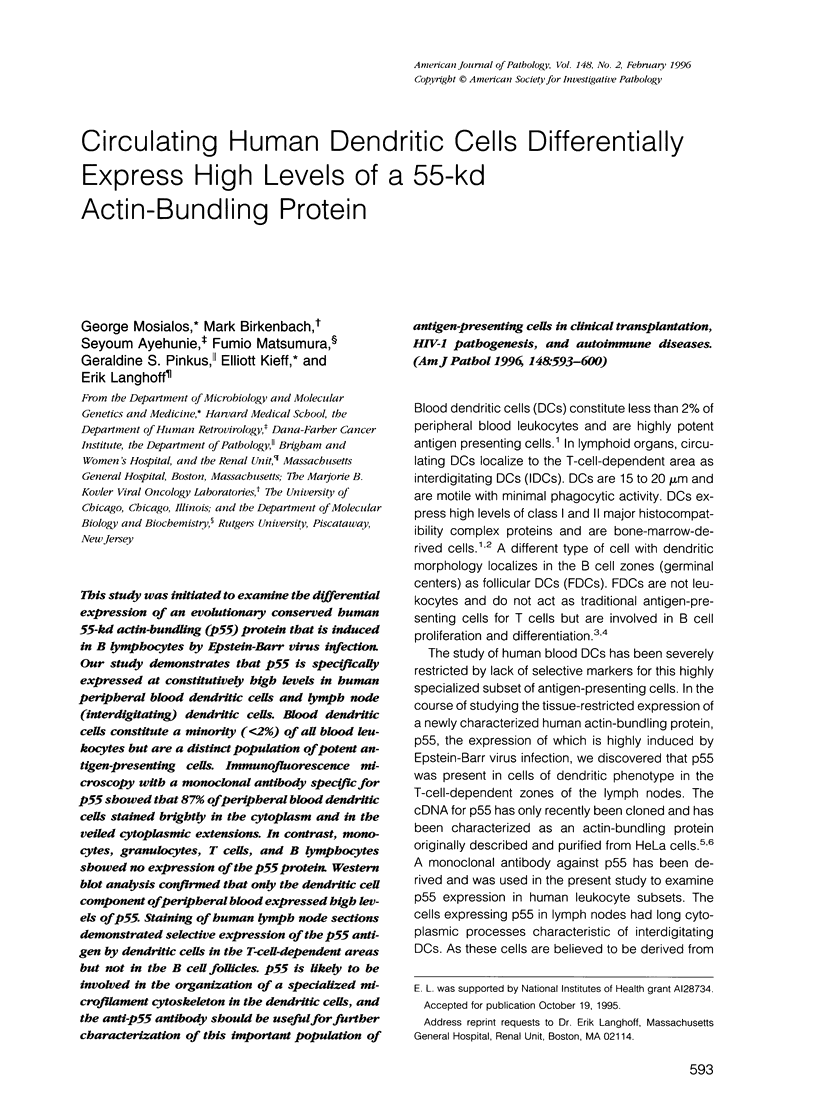
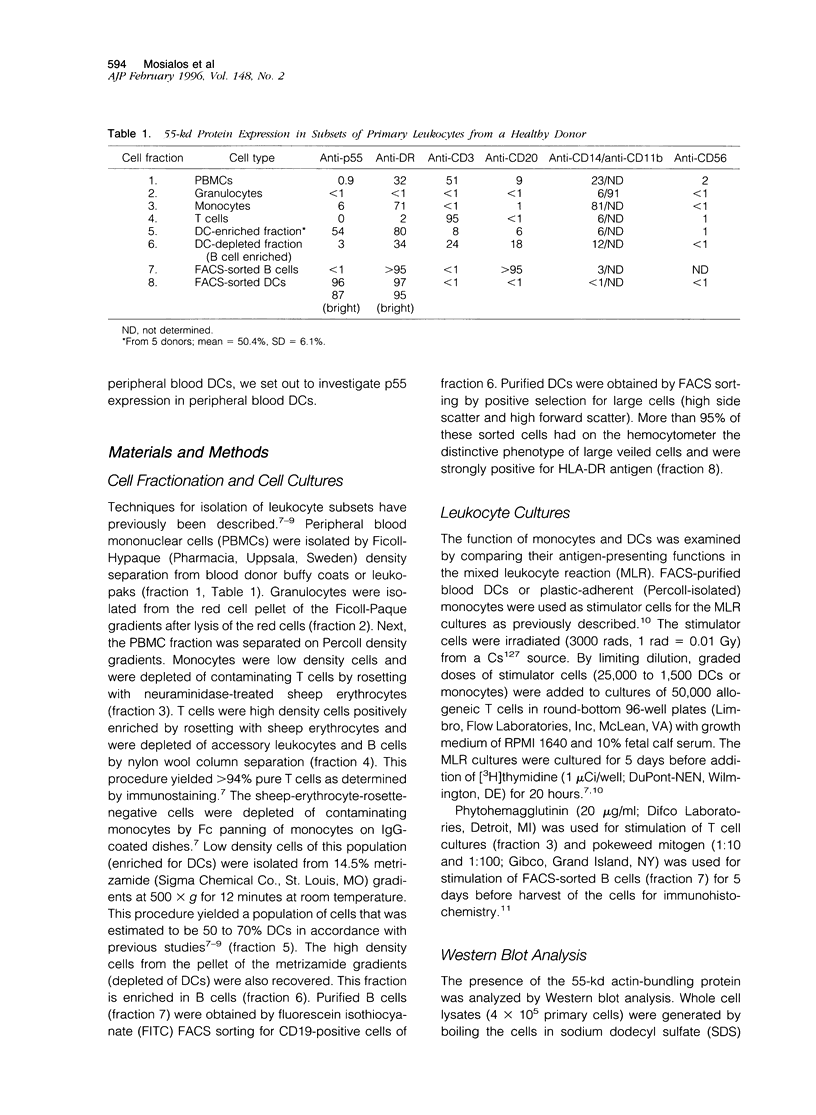
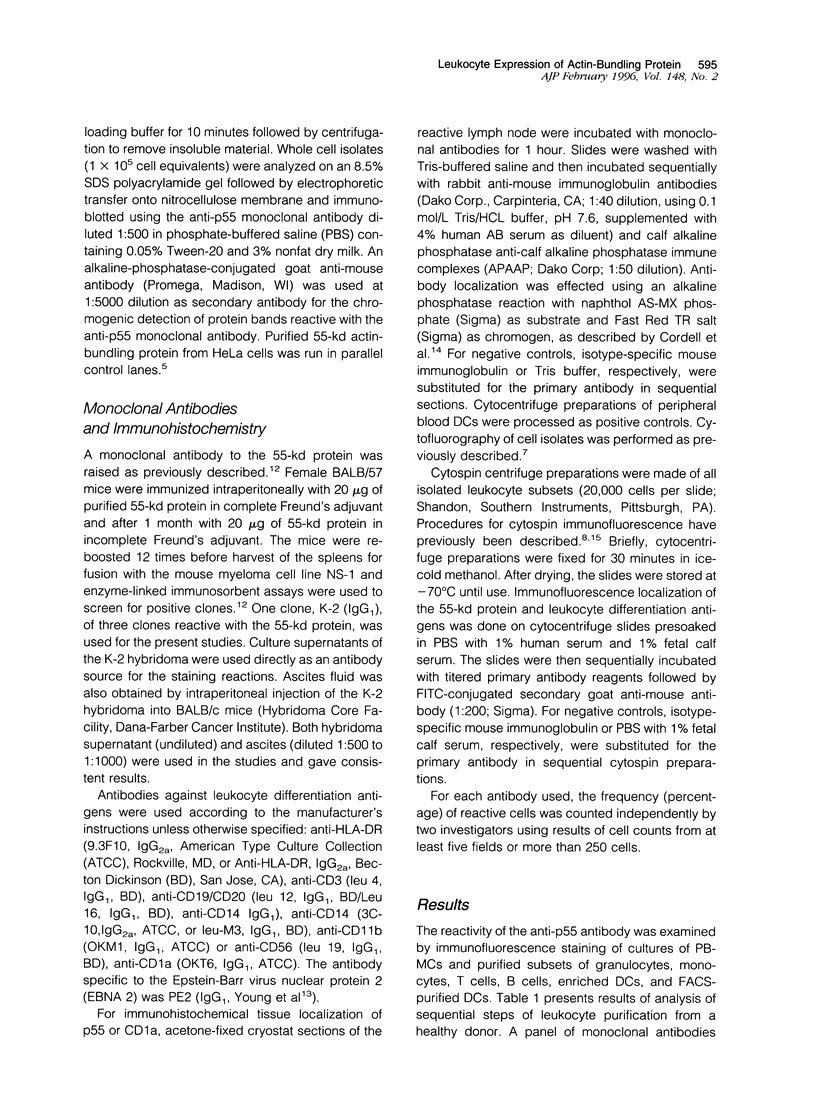

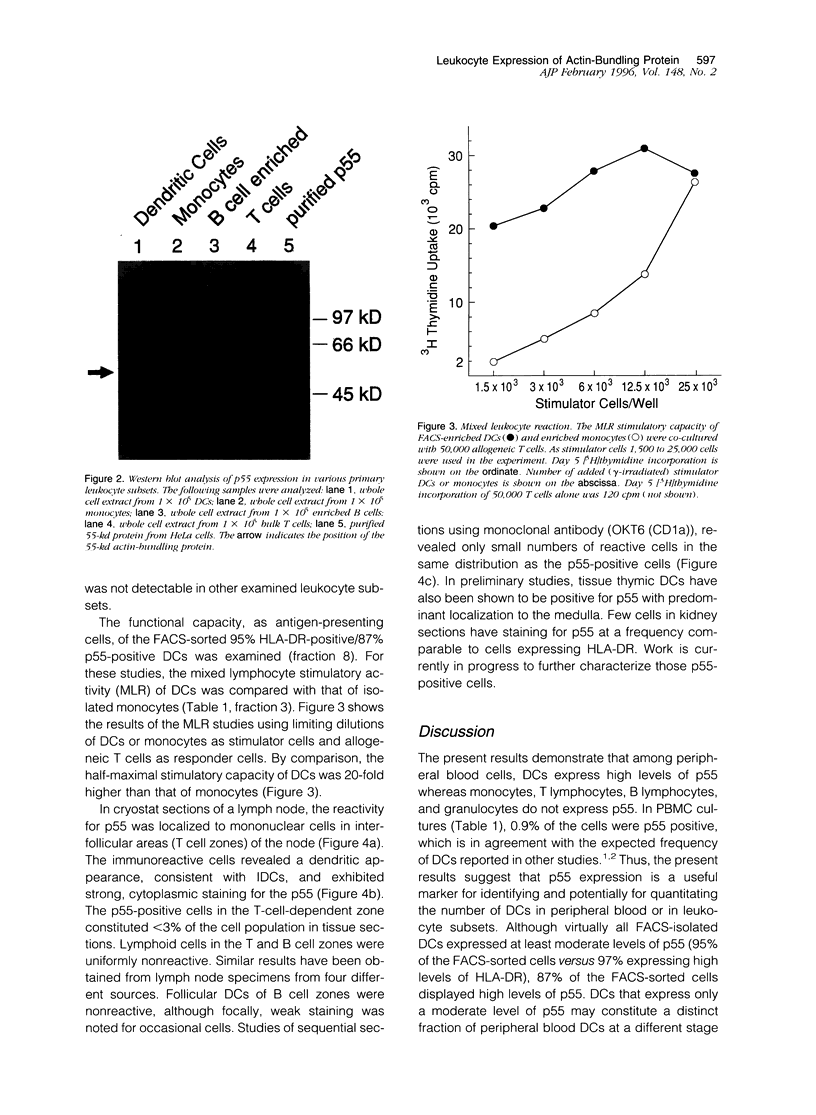

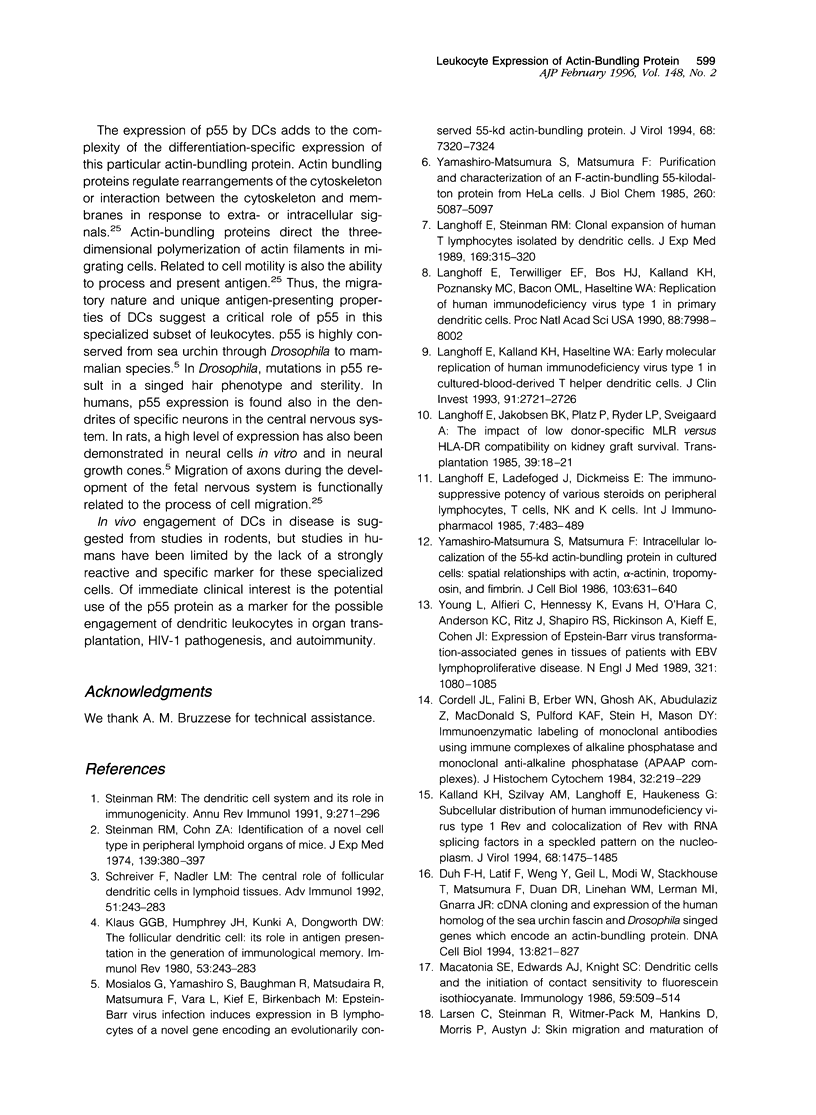
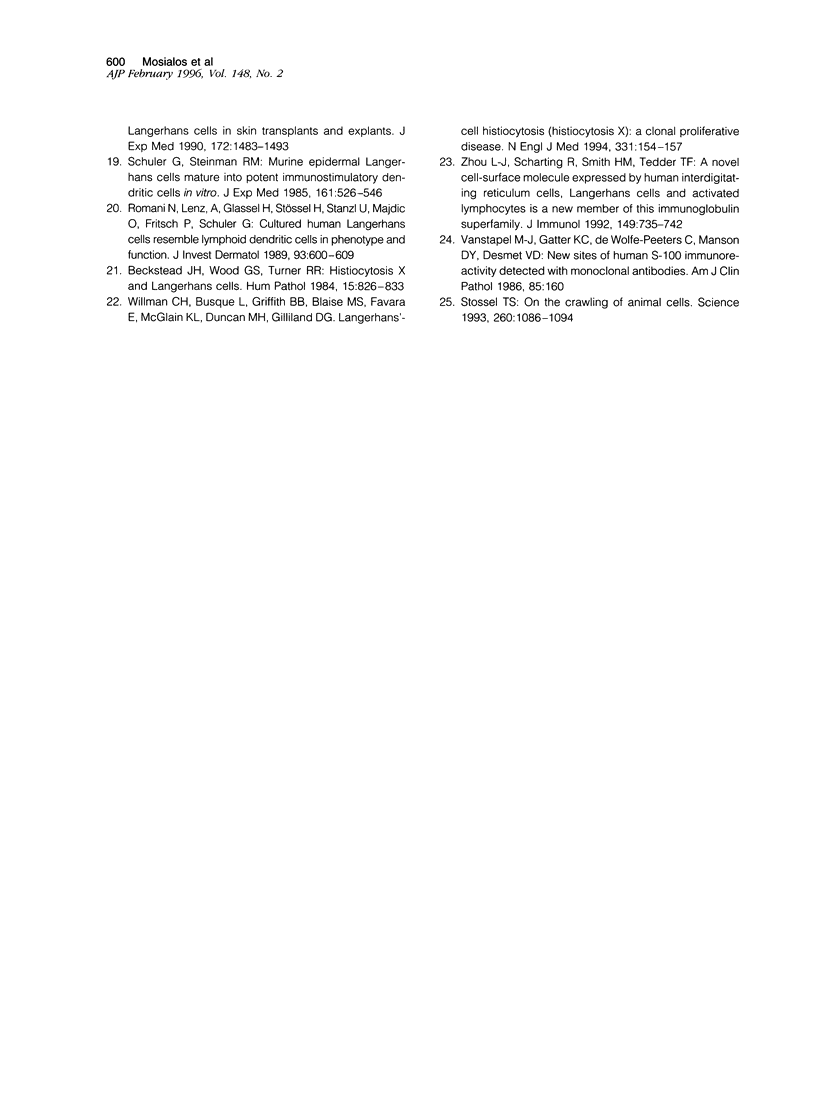
Images in this article
Selected References
These references are in PubMed. This may not be the complete list of references from this article.
- Beckstead J. H., Wood G. S., Turner R. R. Histiocytosis X cells and Langerhans cells: enzyme histochemical and immunologic similarities. Hum Pathol. 1984 Sep;15(9):826–833. doi: 10.1016/s0046-8177(84)80143-4. [DOI] [PubMed] [Google Scholar]
- Cordell J. L., Falini B., Erber W. N., Ghosh A. K., Abdulaziz Z., MacDonald S., Pulford K. A., Stein H., Mason D. Y. Immunoenzymatic labeling of monoclonal antibodies using immune complexes of alkaline phosphatase and monoclonal anti-alkaline phosphatase (APAAP complexes). J Histochem Cytochem. 1984 Feb;32(2):219–229. doi: 10.1177/32.2.6198355. [DOI] [PubMed] [Google Scholar]
- Duh F. M., Latif F., Weng Y., Geil L., Modi W., Stackhouse T., Matsumura F., Duan D. R., Linehan W. M., Lerman M. I. cDNA cloning and expression of the human homolog of the sea urchin fascin and Drosophila singed genes which encodes an actin-bundling protein. DNA Cell Biol. 1994 Aug;13(8):821–827. doi: 10.1089/dna.1994.13.821. [DOI] [PubMed] [Google Scholar]
- Kalland K. H., Szilvay A. M., Langhoff E., Haukenes G. Subcellular distribution of human immunodeficiency virus type 1 Rev and colocalization of Rev with RNA splicing factors in a speckled pattern in the nucleoplasm. J Virol. 1994 Mar;68(3):1475–1485. doi: 10.1128/jvi.68.3.1475-1485.1994. [DOI] [PMC free article] [PubMed] [Google Scholar]
- Langhoff E., Jakobsen B. K., Platz P., Ryder L. P., Svejgaard A. The impact of low donor-specific MLR versus HLA-DR compatibility on kidney graft survival. Transplantation. 1985 Jan;39(1):18–21. [PubMed] [Google Scholar]
- Langhoff E., Kalland K. H., Haseltine W. A. Early molecular replication of human immunodeficiency virus type 1 in cultured-blood-derived T helper dendritic cells. J Clin Invest. 1993 Jun;91(6):2721–2726. doi: 10.1172/JCI116512. [DOI] [PMC free article] [PubMed] [Google Scholar]
- Langhoff E., Ladefoged J., Dickmeiss E. The immunosuppressive potency of various steroids on peripheral blood lymphocytes, T cells, NK and K cells. Int J Immunopharmacol. 1985;7(4):483–489. doi: 10.1016/0192-0561(85)90067-0. [DOI] [PubMed] [Google Scholar]
- Langhoff E., Steinman R. M. Clonal expansion of human T lymphocytes initiated by dendritic cells. J Exp Med. 1989 Jan 1;169(1):315–320. doi: 10.1084/jem.169.1.315. [DOI] [PMC free article] [PubMed] [Google Scholar]
- Langhoff E., Terwilliger E. F., Bos H. J., Kalland K. H., Poznansky M. C., Bacon O. M., Haseltine W. A. Replication of human immunodeficiency virus type 1 in primary dendritic cell cultures. Proc Natl Acad Sci U S A. 1991 Sep 15;88(18):7998–8002. doi: 10.1073/pnas.88.18.7998. [DOI] [PMC free article] [PubMed] [Google Scholar]
- Macatonia S. E., Edwards A. J., Knight S. C. Dendritic cells and the initiation of contact sensitivity to fluorescein isothiocyanate. Immunology. 1986 Dec;59(4):509–514. [PMC free article] [PubMed] [Google Scholar]
- Mosialos G., Yamashiro S., Baughman R. W., Matsudaira P., Vara L., Matsumura F., Kieff E., Birkenbach M. Epstein-Barr virus infection induces expression in B lymphocytes of a novel gene encoding an evolutionarily conserved 55-kilodalton actin-bundling protein. J Virol. 1994 Nov;68(11):7320–7328. doi: 10.1128/jvi.68.11.7320-7328.1994. [DOI] [PMC free article] [PubMed] [Google Scholar]
- Romani N., Lenz A., Glassel H., Stössel H., Stanzl U., Majdic O., Fritsch P., Schuler G. Cultured human Langerhans cells resemble lymphoid dendritic cells in phenotype and function. J Invest Dermatol. 1989 Nov;93(5):600–609. doi: 10.1111/1523-1747.ep12319727. [DOI] [PubMed] [Google Scholar]
- Schriever F., Nadler L. M. The central role of follicular dendritic cells in lymphoid tissues. Adv Immunol. 1992;51:243–284. doi: 10.1016/s0065-2776(08)60489-7. [DOI] [PubMed] [Google Scholar]
- Schuler G., Steinman R. M. Murine epidermal Langerhans cells mature into potent immunostimulatory dendritic cells in vitro. J Exp Med. 1985 Mar 1;161(3):526–546. doi: 10.1084/jem.161.3.526. [DOI] [PMC free article] [PubMed] [Google Scholar]
- Steinman R. M., Cohn Z. A. Identification of a novel cell type in peripheral lymphoid organs of mice. II. Functional properties in vitro. J Exp Med. 1974 Feb 1;139(2):380–397. doi: 10.1084/jem.139.2.380. [DOI] [PMC free article] [PubMed] [Google Scholar]
- Steinman R. M. The dendritic cell system and its role in immunogenicity. Annu Rev Immunol. 1991;9:271–296. doi: 10.1146/annurev.iy.09.040191.001415. [DOI] [PubMed] [Google Scholar]
- Stossel T. P. On the crawling of animal cells. Science. 1993 May 21;260(5111):1086–1094. doi: 10.1126/science.8493552. [DOI] [PubMed] [Google Scholar]
- Vanstapel M. J., Gatter K. C., de Wolf-Peeters C., Mason D. Y., Desmet V. D. New sites of human S-100 immunoreactivity detected with monoclonal antibodies. Am J Clin Pathol. 1986 Feb;85(2):160–168. doi: 10.1093/ajcp/85.2.160. [DOI] [PubMed] [Google Scholar]
- Willman C. L., Busque L., Griffith B. B., Favara B. E., McClain K. L., Duncan M. H., Gilliland D. G. Langerhans'-cell histiocytosis (histiocytosis X)--a clonal proliferative disease. N Engl J Med. 1994 Jul 21;331(3):154–160. doi: 10.1056/NEJM199407213310303. [DOI] [PubMed] [Google Scholar]
- Yamashiro-Matsumura S., Matsumura F. Intracellular localization of the 55-kD actin-bundling protein in cultured cells: spatial relationships with actin, alpha-actinin, tropomyosin, and fimbrin. J Cell Biol. 1986 Aug;103(2):631–640. doi: 10.1083/jcb.103.2.631. [DOI] [PMC free article] [PubMed] [Google Scholar]
- Yamashiro-Matsumura S., Matsumura F. Purification and characterization of an F-actin-bundling 55-kilodalton protein from HeLa cells. J Biol Chem. 1985 Apr 25;260(8):5087–5097. [PubMed] [Google Scholar]
- Young L., Alfieri C., Hennessy K., Evans H., O'Hara C., Anderson K. C., Ritz J., Shapiro R. S., Rickinson A., Kieff E. Expression of Epstein-Barr virus transformation-associated genes in tissues of patients with EBV lymphoproliferative disease. N Engl J Med. 1989 Oct 19;321(16):1080–1085. doi: 10.1056/NEJM198910193211604. [DOI] [PubMed] [Google Scholar]
- Zhou L. J., Schwarting R., Smith H. M., Tedder T. F. A novel cell-surface molecule expressed by human interdigitating reticulum cells, Langerhans cells, and activated lymphocytes is a new member of the Ig superfamily. J Immunol. 1992 Jul 15;149(2):735–742. [PubMed] [Google Scholar]





